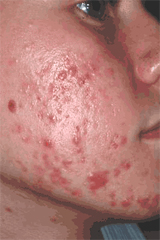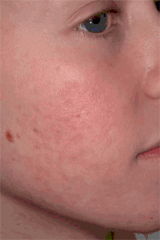 Severe acne, describes acne lesions that are deep, widespread, red and inflamed. The acne may be painful and is likely to lead to permanent acne scars if left untreated.
Severe acne, describes acne lesions that are deep, widespread, red and inflamed. The acne may be painful and is likely to lead to permanent acne scars if left untreated.
Severe acne can cause embarrassment and stress, and limit one’s social life. Fortunately, severe acne can be controlled with the use of prescription acne medications and other procedures.
A bacteria called Propionibacterium acnes (P. acnes) causes the inflammation seen with moderate and severe acne. P. acnes normally lives on the top of the skin, but can infect the oily substance called sebum within the clogged pores. In cases of severe acne, these infected pores (sebaceous glands) burst and release sebum, bacteria, and irritating substances into the deep layers of the skin. This results in even greater inflammation and the development of nodules or cysts.
There are four types of severe acne with overlapping qualities
 1) Nodulocystic Acne (cystic acne) describes acne lesions that are large (several centimeters in diameter), deep, and painful. They may occur alone or on multiple locations over the body. The cyst may appear to be filled with thick, yellow pus-like fluid. Drainage of an acne cyst should be performed in the doctor’s office, not at home. Cysts that arise close together may merge, resulting in large areas of inflammation and skin damage. This results in acne conglobata.
1) Nodulocystic Acne (cystic acne) describes acne lesions that are large (several centimeters in diameter), deep, and painful. They may occur alone or on multiple locations over the body. The cyst may appear to be filled with thick, yellow pus-like fluid. Drainage of an acne cyst should be performed in the doctor’s office, not at home. Cysts that arise close together may merge, resulting in large areas of inflammation and skin damage. This results in acne conglobata.
2) Acne conglobata is most common in males 18 to 30 years old. Acne conglobata appears with deep abscesses, significant inflammation, and acne scars. Blackheads (open comedones) are widespread and may appear on the neck, shoulders, chest, back, and buttocks. The severe acne lesions grow in size and discharge pus before developing thick scars (keloids).
3) Acne Fulminans describes the rapid onset of highly destructive acne that may be accompanied by fever and aching joints.
4) Gram-negative folliculitis is a type of severe acne caused by a class of "gram negative" bacteria that infect the hair follicles on the skin. Gram-negative folliculitis often occurs in people who have been treated with antibiotics for prolonged periods. The treatment of this skin condition requires the use of select antibiotics since "gram negative" bacteria are not killed by the antibiotics normally used to treat acne.
Severe Acne Treatment
Severe acne requires aggressive treatment. Acne treatment options include the following:
- Isotretinoin
- Oral antibiotics, such as doxycycline, or minocycline
- Intralesional corticosteroid injections may be used to treat acne cysts. The acne medication reduces the inflammation and "melts" away the cyst over a period of 3 to 5 days.
- Acne surgery (excision and drainage of the cyst).
Severe acne may require months of treatment to see significant improvement. During this period, it is very important to take the acne medication every day as recommended. It takes time for the inflammation to subside and the skin to heal, but meanwhile the medication will be hard at work keeping preventing new acne lesions and acne scars.
Treatment for severe acne may need to be repeated multiple times over the years because of the high chance of the acne returning. Regular skin checks should be performed to ensure that acne remains under control.
Source: Vivacare
Last updated : 2/8/2021